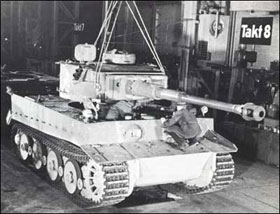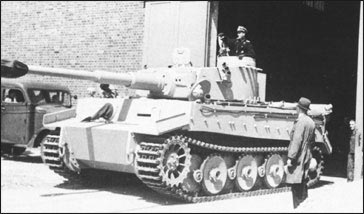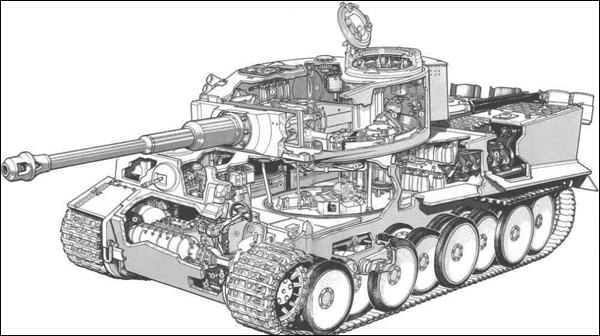 PzKpfw VI Tiger I, or SdKfz 181. |

|
 |
| Lowering the turret onto the hull was done near the end of the assembly process. | The finished product - a new Tiger left the assembly line at the Henschel works in Kassel. |
Production
Henschel und Sohn, of Kassel, Germany, was a well-known manufacturer of heavy industrial and railroad equipment, especially railroad locomotives and large dock cranes. Because of the size and weight of the Tiger, Henschel was considered to be the ideal manufacturer, having all the facilities needed to produce such a heavy vehicle. Henschel also had a fine engineering staff, and a complete vehicle test facility. The final assembly hall at Henschel's plant dwarfed the tanks being produced there and the final assembly line was capable of producing several tanks a day. Although much of the installed equipment on the Tiger was subcontracted, Henschel manufactured most of the major components in their plant. Hulls, turrets, and other contract items and assemblies were brought into the assembly building where final machining operations and detail assembling were done. Henschel's facilities allowed the firm to machine the turret rings and other critical areas of the hull within the plant without outside assistance.
Tiger I Production Statistics April 1942 - August 1944
|
Month and Year
|
Monthly Goal
|
Accepted
|
Normal
|
Befehls
|
Rebuilt
|
Chassis Nr.
|
| April 1942 |
0
|
0+V1
|
1
|
0
|
0
|
|
| May 1942 |
0
|
0
|
1
|
0
|
0
|
|
| June 1942 |
5
|
1
|
0
|
0
|
0
|
25001
|
| July 1942 |
15
|
0
|
0
|
0
|
0
|
|
| August 1942 |
10
|
8
|
9
|
0
|
0
|
25009
|
| September 1942 |
15
|
3
|
2
|
0
|
0
|
250012
|
| October 1942 |
16
|
10+V2
|
8
|
0
|
0
|
250022
|
| November 1942 |
18
|
17
|
14
|
0
|
0
|
250039
|
| December 1942 |
30
|
37+V3
|
35
|
0
|
0
|
250076
|
| January 1943 |
30
|
35
|
30
|
0
|
1
|
250111
|
| February 1943 |
30
|
32
|
30
|
3
|
0
|
250143
|
| March 1943 |
40
|
41
|
35
|
4
|
0
|
250184
|
| April 1943 |
45
|
43
|
42
|
5
|
0
|
250230
|
| May 1943 |
50
|
50
|
43
|
4
|
0
|
250280
|
| June 1943 |
60
|
60
|
49
|
6
|
0
|
250340
|
| July 1943 |
65
|
65
|
53
|
4
|
0
|
250405
|
| August 1943 |
70
|
60
|
63
|
11
|
0
|
250465
|
| September 1943 |
75
|
85
|
48
|
7
|
0
|
250550
|
| October 1943 |
80
|
50
|
82
|
3
|
0
|
250600
|
| November 1943 |
84
|
56
|
34
|
2
|
0
|
250656
|
| December 1943 |
88
|
67
|
80
|
0
|
0
|
250723
|
| January 1944 |
93
|
93
|
78
|
9
|
0
|
250816
|
| February 1944 |
95
|
95
|
96
|
6
|
1
|
250911
|
| March 1944 |
95
|
86
|
84
|
4
|
1
|
250997
|
| April 1944 |
95
|
104
|
88
|
6
|
3
|
251101
|
| May 1944 |
95
|
100
|
79
|
6
|
5
|
251201
|
| June 1944 |
75
|
75
|
100
|
4
|
5
|
251276
|
| July 1944 |
58
|
64
|
63
|
2
|
8
|
251340
|
| August 1944 |
9
|
6
|
13
|
3
|
11
|
251346
|
| TOTAL |
1441
|
1349
|
1260
|
89
|
35
|
|
| Source: JENTZ, Thomas L.; Germany's TIGER Tanks - Tiger I and II: Combat Tactics; ISBN 0-7643-0225-6 | ||||||
Like all German Panzers, the Tiger I was subject of continuous changes and additions, as it became obvious that improvements could be made in the performance and effectiveness of the Tiger. Gradually the various problems reported were worked out, although some were never solved completely. The problems with ice and snow freezing on the interleaved road wheels were not solved until the introduction of the Tiger II with overlapping, not interleaved, road wheels In May, 1943, the Maybach HK 230 P45 engine with two air filters was installed in place of the Maybach HL 210 P45, and the transmission was improved, and with this upgrade the Tiger performance improved in normal use. In July 1943, the turret was extensively redesigned. A new commanders cupola with periscopes and a swivel hatch was installed, and along other modifications, an improved spring counter balance connected with a chain was installed for the 88 mm main gun.

Starting in September, 1943, Zimmerit
anti-magnetic coating was applied at the factory to all upright surfaces
that could be reached by a man standing on the ground. The surface was
rippled to increase the distance to the steel surface without increasing
the weight of the coating. From January 1944 on, the Nahverteidigungswaffe
(close defense weapon) was mounted on the turret roof. This weapon could
fire smoke cartridges, signal cartridges, and grenades, but due to shortages,
was not mounted on the Tiger I until March 1944. In February 1944, steel
road wheels with internal rubber cushioning, adopted from the Tiger II,
were mounted in the Tiger I. These were chosen because of their ability
to bear the weight of heavy armored vehicles.
From March 1944 on, the 25 mm roof plate was increased to 40 mm, to prevent
penetration by large caliber artillery shells (over 150 mm), and the
loader's hatch originally designed for the Tiger II turret was installed
in the thicker turret roof. Finally, in April 1944, The monocular Turmzielfernröhr
9c sighting telescope replaced the previously used binocular Turmzielfernröhr
9b (JENTZ, Thomas L.; Germany's TIGER Tanks - Tiger I and II: Combat
Tactics; op. cit.).
While the Germans stayed close to their original production schedule for the Tiger, it is interesting to note that, for example, during Operation Zitadelle (the Kursk Offensive - July 1943) there were a total of only 133 Tigers available at the start of the offensive - 45 serving with sPzAbt.503, 13 with 13 Kp.SSPzRgt1 (LSSAH), 14 with 8.Kp.SSPzRgt2 (Das Reich), 15 with s.Kp.SSPzRgt3 (Totenkopf), 15 with 13.Kp.PzRgtGD (Großdeutschland), and finally 31 with sPzAbt.505. A total of 19 Tigers arrived as replacements during Operation Zitadelle: 5 for 13.Kp.SSPzRgt1 (LSSAH), and 14 for sPzAbt. 505. From 5 July to 20 July 1943, 13 Tigers were lost (total writeoffs): 4 by sPzAbt.503, 1 by 13.Kp.SSPzRgt1 (LSSAH), 1 by 8.Kp.SSPzRgt2 (Das Reich), 1 by s.Kp.SSPzRgt3 (Totenkopf), and 6 by sPzAbt.505 (JENTZ, Thomas L.; Germany's TIGER Tanks - Tiger I and II: Combat Tactics; op. cit.).
By February 1944, sPzAbt.502 had 71 Tiger I tanks. At the same time, sPzAbt.503, 507, and 509 had respectively 69, 56 and 58 Tigers. This was due to transfers from other units training with the Tiger II, or due to the delivery of the last production Tiger I models. Tiger I production reached its peak between January and May 1944. Anyway, the maximum degree of success attained by the Tiger units was limited and/or localized tactical superiority. The truth was that the German industry simply couldn't produce Tigers in sufficient numbers to make any difference in the big picture - it was a task well beyond wartime German industry capabilities. Just as a comparison on productive capabilities, the Russians produced 23,937 T-34/76 from 1942 to 1945. The American Pershing tank was built at a rate of 1,350 tanks over a six month period. When production ceased in June 1945, 49,234 Sherman tanks had been built - more than all the German tank production during the entire war. In the end, it was this difference in production philosophy and faster Allied production that made the difference between defeat and victory. The real failure of the German very heavy tanks was that they exceeded the capabilities of the German industry to produce them in sufficient numbers.
Every bit of information on www.fprado.com/armorsite is for the purpose of information, criticism, comment, news reporting, teaching, scholarship, and/or research.
The ARMOR Site! is © Copyright 1997-2005 Fabio Prado . All Rights Reserved.
